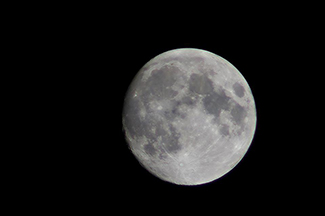What Can We Conclude About Cause-and-effect From Correlational Data?
Learning Objectives
- Explain what a correlation coefficient tells us about the relationship betwixt variables
- Depict why correlation does not mean causation
Did yous know that equally sales in ice cream increase, so does the overall rate of offense? Is it possible that indulging in your favorite flavor of ice cream could send you on a crime spree? Or, after committing criminal offense exercise you recall yous might determine to care for yourself to a cone? There is no question that a relationship exists between ice foam and criminal offence (e.g., Harper, 2013), but it would exist pretty foolish to decide that one matter actually caused the other to occur.
It is much more likely that both ice cream sales and criminal offense rates are related to the temperature outside. When the temperature is warm, there are lots of people out of their houses, interacting with each other, getting bellyaching with 1 some other, and sometimes committing crimes. Also, when it is warm outside, we are more likely to seek a cool treat like ice foam. How do we determine if at that place is indeed a human relationship between two things? And when there is a relationship, how can we discern whether it is attributable to coincidence or causation?
Correlational Inquiry
Correlation means that there is a relationship between two or more variables (such as ice cream consumption and offense), but this relationship does not necessarily imply crusade and effect. When two variables are correlated, it simply ways that as one variable changes, so does the other. Nosotros can measure correlation by computing a statistic known equally a correlation coefficient. A correlation coefficient is a number from -one to +one that indicates the strength and direction of the human relationship between variables. The correlation coefficient is usually represented past the letter r.
The number portion of the correlation coefficient indicates the forcefulness of the relationship. The closer the number is to 1 (be it negative or positive), the more strongly related the variables are, and the more predictable changes in i variable will exist as the other variable changes. The closer the number is to zero, the weaker the relationship, and the less predictable the relationships between the variables becomes. For instance, a correlation coefficient of 0.nine indicates a far stronger human relationship than a correlation coefficient of 0.iii. If the variables are not related to 1 another at all, the correlation coefficient is 0. The example to a higher place virtually ice foam and crime is an example of two variables that nosotros might expect to accept no relationship to each other.
The sign—positive or negative—of the correlation coefficient indicates the direction of the relationship (Figure ane). A positive correlation means that the variables move in the same management. Put another way, it means that as 1 variable increases so does the other, and conversely, when 1 variable decreases so does the other. A negative correlation means that the variables movement in opposite directions. If ii variables are negatively correlated, a decrease in 1 variable is associated with an increase in the other and vice versa.
The instance of ice foam and law-breaking rates is a positive correlation considering both variables increment when temperatures are warmer. Other examples of positive correlations are the relationship between an individual's height and weight or the relationship between a person'south age and number of wrinkles. One might expect a negative correlation to exist betwixt someone's tiredness during the day and the number of hours they slept the previous night: the amount of slumber decreases as the feelings of tiredness increase. In a real-earth case of negative correlation, student researchers at the University of Minnesota found a weak negative correlation (r = -0.29) between the average number of days per week that students got fewer than 5 hours of slumber and their GPA (Lowry, Dean, & Manders, 2010). Go on in heed that a negative correlation is not the same as no correlation. For example, we would probably find no correlation between hours of sleep and shoe size.
As mentioned before, correlations have predictive value. Imagine that you are on the admissions commission of a major academy. You are faced with a huge number of applications, but you are able to accommodate only a small percentage of the applicant pool. How might you lot make up one's mind who should exist admitted? You might try to correlate your current students' college GPA with their scores on standardized tests like the Sabbatum or Human action. By observing which correlations were strongest for your current students, you could use this information to predict relative success of those students who have practical for admission into the university.

Figure ane. Scatterplots are a graphical view of the strength and direction of correlations. The stronger the correlation, the closer the data points are to a direct line. In these examples, we run into that at that place is (a) a positive correlation between weight and height, (b) a negative correlation between tiredness and hours of sleep, and (c) no correlation between shoe size and hours of slumber.
Link to Learning
Dispense this interactive scatterplot to practice your understanding of positive and negative correlation.
Correlation Does Non Betoken Causation
Correlational research is useful because it allows us to discover the strength and management of relationships that exist between two variables. All the same, correlation is limited because establishing the beingness of a relationship tells u.s. little about crusade and effect. While variables are sometimes correlated considering one does cause the other, it could also exist that another factor, a confounding variable, is actually causing the systematic move in our variables of interest. In the ice cream/crime rate instance mentioned before, temperature is a confounding variable that could business relationship for the relationship between the two variables.
Even when we cannot point to clear confounding variables, nosotros should non presume that a correlation between 2 variables implies that 1 variable causes changes in some other. This can be frustrating when a cause-and-issue relationship seems clear and intuitive. Think back to our discussion of the research done by the American Cancer Society and how their research projects were some of the first demonstrations of the link between smoking and cancer. It seems reasonable to assume that smoking causes cancer, but if we were limited to correlational research, nosotros would be overstepping our bounds by making this supposition.
Unfortunately, people mistakenly make claims of causation equally a function of correlations all the time. Such claims are especially mutual in advertisements and news stories. For example, recent research found that people who eat cereal on a regular basis achieve healthier weights than those who rarely consume cereal (Frantzen, Treviño, Echon, Garcia-Dominic, & DiMarco, 2013; Barton et al., 2005). Guess how the cereal companies written report this finding. Does eating cereal actually cause an individual to maintain a healthy weight, or are there other possible explanations, such as, someone at a healthy weight is more than likely to regularly eat a healthy breakfast than someone who is obese or someone who avoids meals in an effort to diet (Figure 2)? While correlational inquiry is invaluable in identifying relationships among variables, a major limitation is the disability to establish causality. Psychologists want to make statements about cause and effect, simply the only fashion to do that is to conduct an experiment to reply a research question. The next section describes how scientific experiments comprise methods that eliminate, or control for, alternative explanations, which allow researchers to explore how changes in one variable crusade changes in some other variable.
Link to Learning
Watch this clip from Freakonomics for an example of how correlation doesnotbespeak causation.

Figure 2. Does eating cereal really crusade someone to be a healthy weight? (credit: Tim Skillern)
Illusory Correlations
The temptation to make erroneous cause-and-consequence statements based on correlational research is not the but mode we tend to misinterpret information. We also tend to make the mistake of illusory correlations, especially with unsystematic observations. Illusory correlations, or faux correlations, occur when people believe that relationships exist between ii things when no such relationship exists. One well-known illusory correlation is the supposed effect that the moon's phases accept on human being behavior. Many people passionately assert that man behavior is affected by the phase of the moon, and specifically, that people human action strangely when the moon is full (Effigy 3).

Many people believe that a full moon makes people acquit oddly. (credit: Cory Zanker)
There is no denying that the moon exerts a powerful influence on our planet. The ebb and menstruum of the ocean's tides are tightly tied to the gravitational forces of the moon. Many people believe, therefore, that it is logical that we are affected by the moon as well. Subsequently all, our bodies are largely made up of h2o. A meta-analysis of nearly twoscore studies consistently demonstrated, even so, that the relationship between the moon and our behavior does not exist (Rotton & Kelly, 1985). While we may pay more attention to odd behavior during the full phase of the moon, the rates of odd behavior remain constant throughout the lunar wheel.
Why are we so apt to believe in illusory correlations like this? Oft nosotros read or hear about them and simply accept the information as valid. Or, nosotros have a hunch most how something works and so wait for evidence to support that hunch, ignoring evidence that would tell us our hunch is imitation; this is known every bit confirmation bias. Other times, we find illusory correlations based on the data that comes most hands to listen, even if that data is severely express. And while we may experience confident that nosotros tin can utilise these relationships to amend understand and predict the earth around us, illusory correlations can have significant drawbacks. For example, inquiry suggests that illusory correlations—in which certain behaviors are inaccurately attributed to certain groups—are involved in the formation of prejudicial attitudes that can ultimately lead to discriminatory behavior (Fiedler, 2004).
Think Information technology Over
1. We all accept a tendency to brand illusory correlations from time to time. Endeavour to think of an illusory correlation that is held by you, a family member, or a shut friend. How do you remember this illusory correlation came almost and what can be done in the future to combat them?
Glossary
crusade-and-effect relationship:changes in one variable crusade the changes in the other variable; can be adamant only through an experimental research design
confirmation bias:tendency to ignore testify that disproves ideas or beliefs
misreckoning variable:unanticipated outside cistron that affects both variables of interest, frequently giving the false impression that changes in one variable causes changes in the other variable, when, in actuality, the exterior factor causes changes in both variables
correlation:relationship between 2 or more than variables; when ii variables are correlated, one variable changes as the other does
correlation coefficient:number from -1 to +i, indicating the strength and direction of the relationship between variables, and unremarkably represented by r
illusory correlation:seeing relationships between two things when in reality no such relationship exists
negative correlation:two variables change in different directions, with i condign larger as the other becomes smaller; a negative correlation is not the same thing as no correlation
positive correlation two variables modify in the same direction, both becoming either larger or smaller
Source: https://courses.lumenlearning.com/msstate-waymaker-psychology/chapter/reading-correlational-research/
0 Response to "What Can We Conclude About Cause-and-effect From Correlational Data?"
Postar um comentário